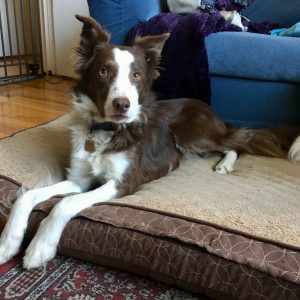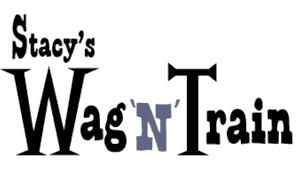“Incompatible behaviors” teach your dog the right way to act
© Stacy Braslau-Schneck, CPDT

In the Quick-Fix training tips I listed a number of management techniques you can use to immediately stop your dog from doing some of the behaviors you really don’t like, but I noted that these were stop-gap measures. The doors, gates, leashes, crates and other physical tools you use to control your dog must always be maintained to keep the situation under control, and meanwhile the dog doesn’t learn any new way to behave. For long-lasting behavior change, you need to do some training, and the best way to teach your dog to stop doing one thing is to teach her to start another – something that’s incompatible with the action you don’t like.
Some simple behaviors can be used to solve a lot of common dog problems:
If a dog is looking at you (making eye contact), he’s not
- watching or chasing squirrels, cats, birds or other dogs;
- running away;
- sniffing the ground or finding trash
- pulling on the leash
- staring at other dogs “aggressively”
Train “pay attention” or “watch me” (you can also use the dog’s name as a cue) by clicking and treating each time the dog looks at you. Start in a situation with little or no distractions. If your timing is good, you will be able to catch the dog’s littlest glances. A great exercise for practicing attention with distractions is the “Eye Contact Game”: hold a piece of food out to one side, out of your dog’s reach. The moment the dog glances from the treat to your face, click and give him the treat. (Flipper and I played this every morning at the park. When we arrive at the park gate I wait for him to look at me before I’ll remove the leash. His reward for giving me eye contact is the release, “OK, go play!”).
If a dog is sitting, he’s not:
- jumping up
- stealing things
- climbing on the counters
- climbing into your lap
- sticking his nose in the refrigerator
- running through the door, etc.
Train “sit” by clicking and treating each time the dog sits. Start when there are few distractions and you may be able to “capture” when the dog sits naturally. If you can’t capture it, lure it: hold a good smelly treat in front of the dog’s nose, and slowly move it back just along the top of the dog’s head. As the dog’s nose follows the treat, the dog’s butt will lower to the floor. (If the dog jumps up to get the treat, hold it lower and don’t let the dog get it. If the dog walks backwards, hold the treat higher and/or start with the dog against a wall so he can’t back up). If you have a dog that never sits (like a greyhound), train “down” instead.
If a dog is chewing on a bone, a stuffed Kong, or a rawhide, or playing with a BusterCube or Roll-A-Treat, he’s not:
- digging
- barking
- chewing your furniture, shoes, or house
- jumping the fence
- chasing other animals
- stealing your stuff
- “countersurfing” (looking for goodies on your counters)
- whining or scratching
Finally, here’s a table with some long-term solutions to many behavior problems that training an incompatible behavior can help with.
| To Stop: | Train instead: |
| Jumping on people to greet them | “Sit”. Alternatively, train “down”, “go to your place” or “Get a toy” |
| Pulling on a leash | Reward walking on a loose leash. Train the dog to look at you while walking. |
| Lunging at strangers | Reward walking on a loose leash. Train the dog to look at you while walking. Ask the dog to touch your hand with his nose (see “Target Training” Tip). |
| Bark at mail delivery or doorbell | “Go to your place” or “get a toy” – with the sound of the mail being delivered or the doorbell as the cue. |
| Running through the door | “Wait” or “Sit Stay” |
| Running away | “Come”. Or “sit”, “down”, “play dead” or any other incompatible behavior |
| Barking, whining, nudging, scratching, jumping on you, etc., to get your attention | Any trick or action that is less annoying! Be sure that you only respond to your dog when YOU want to. Ideally the dog will only perform these tricks on command, and she will get enough attention, activity and exercise for her to not need to beg for attention. |
| Begging at the table | “Go to your place” |
| Barking | “Down” (you can end barking a number of other ways as well; see the Barking training tip) |
| Making eye contact with other dogs, inciting them to play or aggression | “Pay attention” or hand touch (touch your hand with his nose – see the “Target Training” Tip). |
For further information, see Terry Ryan’s book, “Toolbox for Remodeling The Problem Dog” available at Dogwise.com.
Go to Quick-Fix tools for stopping unwanted behavior NOW!
Last updated December 20, 1999 by Stacy Braslau-Schneck.
All material copyright Stacy Braslau-Schneck. Reprints for non-commercial use, and with the author’s permission only.
Would you, your training company, or your club like to reprint this? Please be sure to keep my name, business name, and the website URL with the article, and if possible, please send me a copy.
See the Contact page for email and mailing address.

